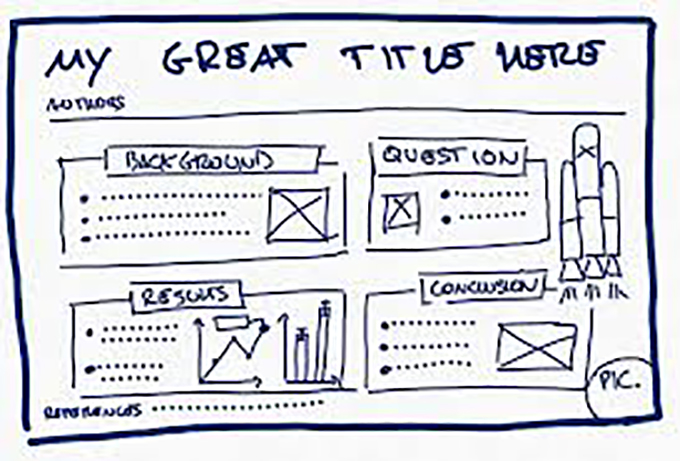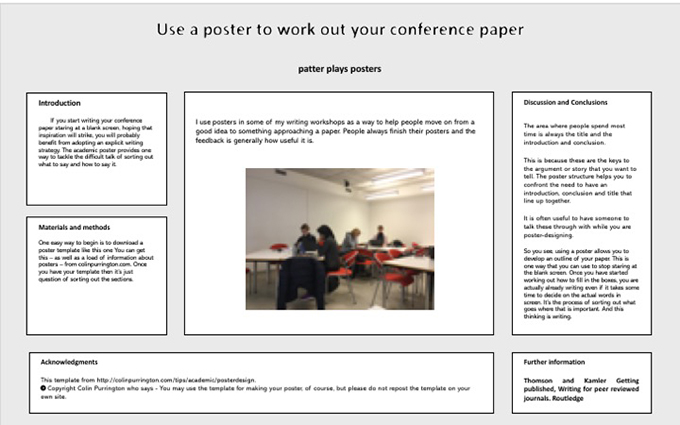
Im quite a fan of the academic research poster. However, posters have a bad reputation in some quarters. They’re sometimes seen as a “less than” – less than a conference paper, a second rate public presentation.
Ever heard anyone say – Oh my paper didn’t get in the main conference papers but they offered me a poster instead. It’s not worth me going in that case. Sound familiar? Or perhaps – There’s a poster session on next. I can give that a miss. There won’t be anything much for me there. That too?
These are an unfair and ill-deserved rap in my view. But not uncommon.
Presenting a poster at a conference can be A Good Thing.
Of course, for that to happen, the conference needs to have dedicated a posters time slot. Posters ought not to be something that get squeezed in instead of lunch – no time allowed really does say to people, this conference has posters but we don’t really value them.
But if the conference has been conscious of posters, has set aside time and advertised the session(s), then you may well find that the people who come to see your poster – with you standing next to it with your paper or handout – will actually be really interested. They will want to talk. The poster offers you the opportunity to chat, and there’s more chance of finding out where interests overlap. And who knows where that may go.
The research poster has uses after the conference too. It can be displayed in your office or corridor so that people in your building can see what you are doing. Very often, we don’t know that much about what the people we work with are actually researching, and posters on display give us the chance to see – and then follow up. And it’s good for students and visitors too to come into a building and see the kinds of research work that is done there.
BUT…
There’s another use for posters too. And that’s as a strategy to prepare a paper. Yes, a poster is a great way to get yourself organised for writing the conference paper or journal article.
Now, I often talk about tiny text abstracts as a way to start off a paper. And of course there’s free writing, the Pomodoro, with its variations of looping, ink-shedding, and use of prompts. You can also storyboard or use Powerpoint to sort out your paper too.
But posters are another good strategy for starting writing. Designing a poster is a bit like an abstract except that its longer. You have to produce more words. A poster is often about a thousand words. That’s not really a lot.
The key to the poster as writing strategy is that you have to sort out
- the title – something that tells a passer-by or prospective visitor to your stand what your work is about, and what you have to say. It helps if your title is more than simply descriptive, but also signals to a reader your take-home point.
- the beginning and end. Sorting out what needs to go at the start and the finish happen together. The introduction and conclusion “shake hands”. Your paper is going to start with some kind of problem, puzzle or question which you answer at the end. Your introduction also needs to set the puzzle in its context – and that context is what the So What and Now What that arise from your conclusion will refer back to. See my poster below for a simple example. I use ‘the blank screen’ at the beginning and end.
- the middle is simple. It’s how you get from the question, problem or puzzle to your conclusion. This process may be through sections which look at literature, methods and results, or it may be a narrative made up of words and pictures. Or anything in between. What’s in the middle often depends on your discipline, and what kind of research you are doing. But whatever the middle of your poster is, it’s what takes up most of the words, because that’s the new stuff that you’ve done.

Designing a poster and sorting out the sections and key content of each of them takes some time. In my writing workshops we usually take a couple of days – with the first day working on the title and the abstract. Then comes the actual poster, which doesn’t have an abstract on it by the way. The poster takes just a few more hours.
And yippee. Once you’ve made your poster, you are well on your way to writing the paper proper. You’ve already got it there in miniature form. You’ve done the hard graft of sorting out the title and the staging of the argument or narrative. It’s not so difficult now to think about working on each section and enlarging them.
Posters can do a lot of work for you in preparing a paper if you commit to them.